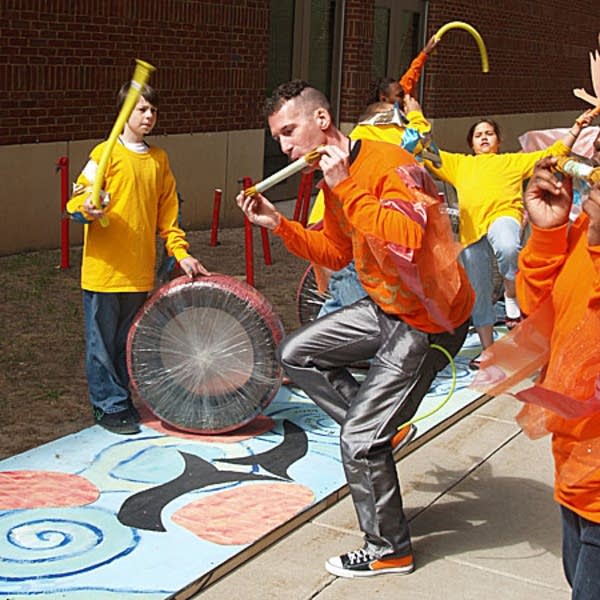Savage Aural Hotbed at 20
Go Deeper.
Create an account or log in to save stories.
Like this?
Thanks for liking this story! We have added it to a list of your favorite stories.

After 20 years, the pounding sonic excursions of Savage Aural Hotbed still sound like a post-apocalyptic symphony. And on stage, the musicians still look like they're trying to start a percussion revolution as they bash their found instruments into submission.
That Savage Aural Hotbed still looks and sounds "out there" in 2009 is a little disappointing to co-founder Mark Black.

"I don't think of us as revolutionaries, as much as other people just aren't doing what they should be doing," Black said. "More people should be exploring and trying out different things."
But since the beginning, the band has been guided by a desire to move in new directions, and maybe redefine what constitutes music.
Turn Up Your Support
MPR News helps you turn down the noise and build shared understanding. Turn up your support for this public resource and keep trusted journalism accessible to all.
"The thing that attracted me to Savage Aural Hotbed was experimentation," said percussionist Stuart DeVaan, who joined the group 17 years ago. "Looking at the world and seeing things and pounding on them, and seeing what other sounds or visual effects that we could come up with me."
There have been almost too many of those innovations to count.
Savage Aural Hotbed members are somewhat shy about discussing their influence and impact. But they light up when giving a tour of their found instrument workshop. They're as much machinists as musicians.

The place looks like an indoor junkyard, but nearly every object is wired for sound. There are metal, fiberglass and plastic barrels, springs, rods, pipes of every width and length -- even graphite sockets Stuart DeVaan says are used for artificial limbs.
"They make a very nice wood block sound with those," he said.
The Savage Aural Hotbed philosophy is if the object is shaped like an instrument, you can probably make music with it. Which explains one of the homemade drums on the floor that looks like it was manufactured by Maytag.
"We call them the dryer drums, because it's the tumbler from a dryer," DeVaan said.

Savage Aural Hotbed doesn't shun more conventional instruments. The "slide clarinet" the group devised features a clarinet mouthpiece attached to some kind of pipe.
But DeVaan is probably most excited about the band's latest invention, which they call the glove of sound.
"It's a glove that we've mounted a contact mic to, with a wireless transmitter," he said. "So whatever we touch, we can play."
DeVaan begins to tap on all the hard surfaces around him.

He then walks over to what he calls the table of sound, which employs the same contact mic technology. Anything you put on the table, says DeVaan, you can mic.
"In this case I've got some aluminum rods coming off the edge of the table, and you can pluck these rods," DeVaan said.
In their workshop, it can seem like Savage Aural Hotbed members have gotten carried away by whimsy. But when you listen to their pieces, you hear how all their inventions serve the music.
Even though they don't like to talk about themselves, it's easy to find others who take their work very seriously.

"It's the kind of band Bart Simpson could only wish that he were in," says Philip Blackburn, senior program director at the American Composers Forum in St. Paul.
Blackburn heads up Innova Records at the Composers Forum, which produced Savage Aural Hotbed's 2006 CD, "Unified Pounding Theory."
Blackburn says the group's music has compositional integrity in addition to its raw energy, which is why it can be enjoyed on a number of levels.
"From the classical end of things, you can sit there counting the numbers and the rhythmic patterns that they must be thinking about in their heads. And if you're not good at arithmetic, just sit back and watch the sparks flying and admire the ingenuity of the whole thing," Blackburn said.
There may not be a lot of other groups locally that sound like Savage Aural Hotbed, but Blackburn says that doesn't mean they've had no impact.

"I think the existence of a band like that is enough to give permission to other people to do whatever they want," Blackburn said.
That's the effect Savage Aural Hotbed had on St. Paul musician, found instrument maker, and composer Mike Croswell.
"When I moved here in '90, it was a total guitar scene," Croswell said. "If you were making electronic noise you were kind of on the outs. And when these guys came along, it's like, 'There's somebody doing what I like.'"
Guitars still dominate the local music scene. But after 20 years, Savage Aural Hotbed is still here too, still laying down a raucous groove by drawing strange sounds out of unlikely objects.
Dear reader,
The trustworthy and factual news you find here at MPR News relies on the generosity of readers like you.
Your donation ensures that our journalism remains available to all, connecting communities and facilitating better conversations for everyone.
Will you make a gift today to help keep this trusted new source accessible to all?





